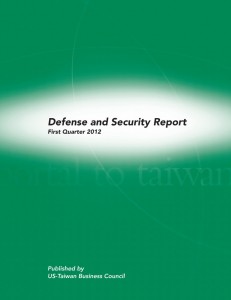Event:
US-Taiwan Defense Industry Conference 2013
September 29-October 1, 2013
Annapolis, Maryland
The US-Taiwan Defense Industry Conference 2013 will be held September 29 – October 1, 2013 in Annapolis, Maryland. This will be the twelfth annual event in a series of ongoing conferences addressing the future of U.S. defense cooperation with Taiwan, the defense procurement process, and Taiwan’s defense and national security needs. This year, conference sessions will discuss Taiwan’s Quadrennial Defense Review (QDR), examine the importance of credibility in sustaining deterrence, and discuss approaches and policies in support of a credible, comprehensive, and strategically relevant deterrence message. We will also examine existing systems and available capabilities that can be leveraged in support of Taiwan defense and national security objectives, as well as assess innovations and future capabilities in support of Taiwan’s national defense and as a component of deterrence.
The first conference in this series was the St. Petersburg, Florida event where former Minister of National Defense Tang Yiau-ming gave the keynote address in March of 2002. The second conference in the series was held in February 2003 in San Antonio, Texas, the third in October 2004 in Phoenix, Arizona, the fourth in September 2005 in San Diego, California, the fifth in September 2006 in Denver, Colorado, and the sixth in September 2007 in Annapolis, Maryland. Taiwan’s Minister of National Defense Chen Chao-min gave the keynote address at the seventh conference in the series, held in September 2008 on Amelia Island, Florida. The eighth conference was held in September 2009 in Charlottesville, Virginia, the ninth conference was held in October 2010 in Cambridge, Maryland, the tenth conference was held in September 2011 in Richmond, Virginia, and the eleventh conference was held in September 2012 in Hershey, Pennsylvania.
Conference Program
Keynote speakers at the 2013 conference will include senior representatives from Taiwan’s Ministry of National Defense and from the U.S. government. US-Taiwan Business Council Chairman Dr. Paul Wolfowitz will serve as the conference host.
Sessions at the US-Taiwan Defense Industry Conference feature a moderator and several speakers on the panel, and some sessions include additional commentators. Each speaker will give a short presentation on the session topic from his or her own viewpoint and expertise. Those presentations will then be followed by a moderator-led discussion among the panelists, as well as a moderator-driven question and answer period with the attendees. This format offers the maximum amount of time for exchanges among the panelists, as well as between the panel and the audience, allowing the sessions to become a forum for substantial and valuable interaction and discussion.
Registration is now open at the 2013 US-Taiwan Defense Industry Conference website.




